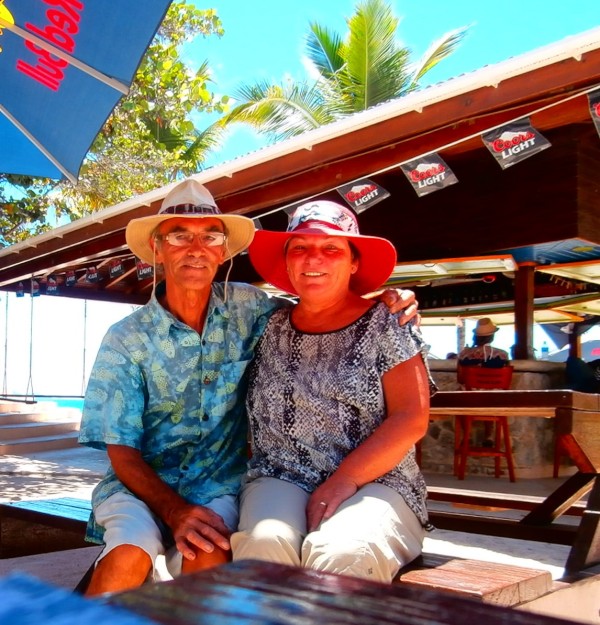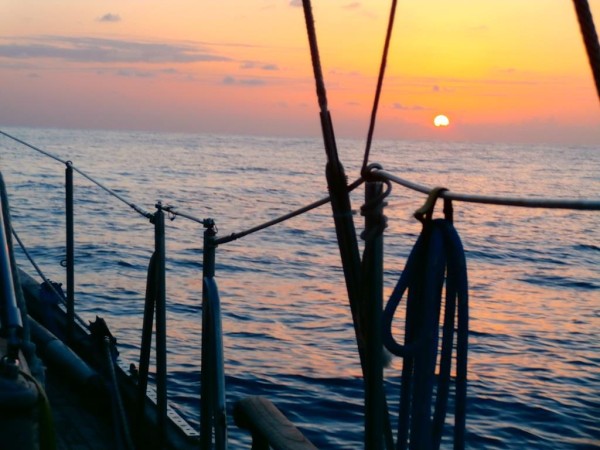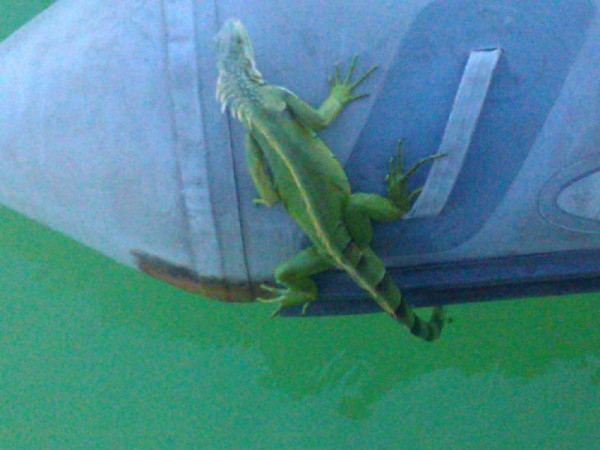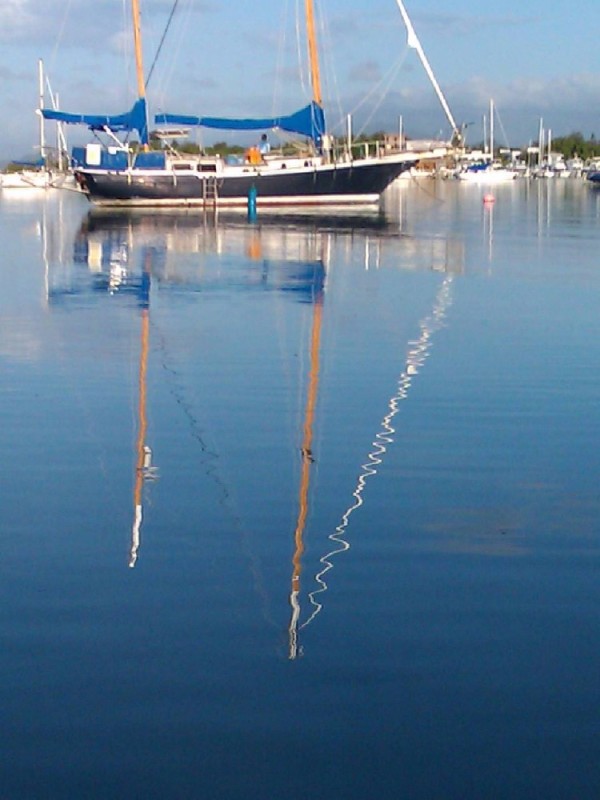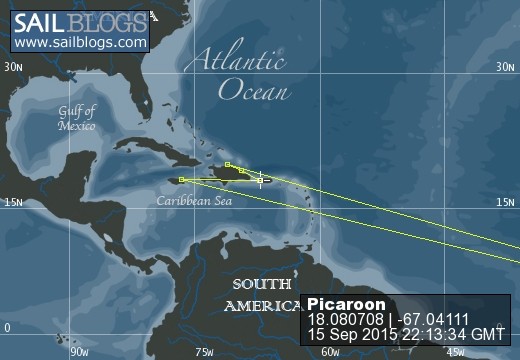
Sailors to seadogs
Jackie & Colins' adventures on the high seas.
09 April 2017
03 April 2017
03 April 2017
29 July 2016
19 July 2016
21 June 2016
20 May 2016
13 March 2016
27 February 2016
27 February 2016
18 November 2015
12 November 2015
27 September 2015
15 September 2015 | Puerto Real Marina
07 September 2015
30 August 2015
30 August 2015
28 July 2015
26 July 2015 | Ile a Vache, Haiti
18 July 2015 | Ila a Vache Haiti
Free at last
17 January 2014 | Salinas, Puero Rico

The biggest full moon has just risen above the mangroves. The first hint was a strange light on the cloud tops as though the setting sun was still lighting distant clouds, but the sun had set an hour ago and it was almost dark anyway. Slowly she revealed herself peeking from behind the cloud and casting dappled rays across the still waters of early evening towards Picaroons bow. Today had been a big day, and it was now wine time. I thought about one small step for man, one giant leap for mankind, you know, when those three guys got on board that rocket and went to the moon. I once went to Cape Canaveral where they have the Apollo capsule on display and what amazed me, looking inside, was that the dashboard looked, for all the world, like a Morris 1000. Ok, so there were obviously a few more switches and dials but it was a far cry from the Star ship Enterprise. To go to the moon and back in that must have taken some courage, and not a little faith.
The previous owner of Picaroon, as I told you, was a rocket scientist, maybe he was a part of that mission, who knows, but aboard the teak space ship we’re almost ready for blast off and today we took our first baby steps and freed ourselves from the mooring buoy. We weren’t going far though, what we wanted to do was to actually anchor Picaroon, something we hadn’t done, and the one bit of sailing that we’ve had very little practice at, most of our voyaging has ended up in marinas.
Weighing in at 28,000 lbs, Picaroon is a heavy boat and so she needs a big heavy anchor, in fact we’ve got two, that hang off the bowsprit, that’s the pole that sticks out of the front, but only one has a chain attached to it, the other is a spare, just in case we lose our primary one, which for some reason is called a Bruce, must be Australian, I suppose. Luckily we don’t have to man handle the anchor or the chain, it’s lowered and raised by this electric winch, which us seadogs call a windlass, that’s up on the pointed end, or bow, and the chain is out of sight in a hole called the chain locker.
The controls to make the anchor go down or up, are on a gadget that is plugged in at the wheel with two buttons, one marked up, and the other marked down, so you don’t get confused, sounds easy eh. Well it’s not because there’s lots that can go wrong when trying to stop a twenty one ton weight from drifting about and colliding with the land, or any of the other fifty yachts that surround us in Salinas bay. So we’ve read and re-read all the stuff we’ve got on anchoring, how you approach the place you want to drop Bruce, how much chain to let out, which you have to calculate by knowing how deep the water is and then multiply that by 4 or 5 or 6 depending on how rough and windy the weather is, or is going to be, we decided on 5.
The chain is marked with tie wraps, that are somewhat faded, every five metres, we think, but as we have never had the chain out this is actually just a wild guess, it could just as easily be marked every ten feet, it will be my job to count the tie wraps as they leave the ship, Jackie will work the windlass from the helm, at the back of Picaroon, a distance of 40ft away from me, so we’ll need hand signals to communicate. Unfortunately, we hadn’t completely agreed what these hand signals would be, and as the engine would drown out any verbal noises I might make, these hand signals could be crucial.
The morning is calm with just a breath of wind, so before breakfast, after our wake up cup of tea, we let go of the mooring line and motor slowly away with the intention of doing a big circle, slipping between the half dozen yachts behind us, and anchoring in a space about 100 yds from where we have been for the last six weeks. The bay is perhaps half a mile wide and in most places is about 12ft deep, we need over six feet of water not to run aground, but there are shallow bits so you’ve got to keep an eye on the depth gauge, unfortunately, we’ve forgotten to turn ours on. It’s a sort of computer screen, with a cover on, and it takes a little while to come to life, so Jackie, whose on the helm wisely decides to head out towards where we know there’s enough depth until the screen pops into life. We manage the big turn, slip between the fleet, and come to a stop where we’ve decided to drop Bruce. The signal is given to fire up the windlass, a thumbs up and a circular movement of my hand seems to work as the chain rattles out of the locker and the anchor disappears below the water. I’m supposed to signal when it hits the bottom, and count the tie wraps as they wiz by, but with the chain being heavy it’s not exactly clear when this happens so I guess it has, and give the signal, arm out straight, Jackie is of course confused by this as we never worked out any signalling, I do a circular sweep indicating to go backwards letting out more chain as we go, which Jackie again doesn’t understand, but she’s read the book and does that anyway. I count the tie wraps, but may have missed one, or two, but no matter we stop paying out the chain after about fifty or sixty feet has left the boat. We seem to have stopped, Jackie gives the engine some revs in reverse, to, in theory dig Bruce into the Salinas bay mud. We check again to see if we’re drifting, but it looks like we’re stopped, and anchored. In the end it all went very smoothly, and a lot easier than we thought. We even put on the snubber, which is a bit of rope attached to the chain to take the weight off the windlass and then it was time for breakfast. The next test will be tomorrow when we try raising the anchor, but before we do that we’ll work out what hand signals we’re going to use, and make sure the depth sounder/chart plotter is turned on before we begin.
The previous owner of Picaroon, as I told you, was a rocket scientist, maybe he was a part of that mission, who knows, but aboard the teak space ship we’re almost ready for blast off and today we took our first baby steps and freed ourselves from the mooring buoy. We weren’t going far though, what we wanted to do was to actually anchor Picaroon, something we hadn’t done, and the one bit of sailing that we’ve had very little practice at, most of our voyaging has ended up in marinas.
Weighing in at 28,000 lbs, Picaroon is a heavy boat and so she needs a big heavy anchor, in fact we’ve got two, that hang off the bowsprit, that’s the pole that sticks out of the front, but only one has a chain attached to it, the other is a spare, just in case we lose our primary one, which for some reason is called a Bruce, must be Australian, I suppose. Luckily we don’t have to man handle the anchor or the chain, it’s lowered and raised by this electric winch, which us seadogs call a windlass, that’s up on the pointed end, or bow, and the chain is out of sight in a hole called the chain locker.
The controls to make the anchor go down or up, are on a gadget that is plugged in at the wheel with two buttons, one marked up, and the other marked down, so you don’t get confused, sounds easy eh. Well it’s not because there’s lots that can go wrong when trying to stop a twenty one ton weight from drifting about and colliding with the land, or any of the other fifty yachts that surround us in Salinas bay. So we’ve read and re-read all the stuff we’ve got on anchoring, how you approach the place you want to drop Bruce, how much chain to let out, which you have to calculate by knowing how deep the water is and then multiply that by 4 or 5 or 6 depending on how rough and windy the weather is, or is going to be, we decided on 5.
The chain is marked with tie wraps, that are somewhat faded, every five metres, we think, but as we have never had the chain out this is actually just a wild guess, it could just as easily be marked every ten feet, it will be my job to count the tie wraps as they leave the ship, Jackie will work the windlass from the helm, at the back of Picaroon, a distance of 40ft away from me, so we’ll need hand signals to communicate. Unfortunately, we hadn’t completely agreed what these hand signals would be, and as the engine would drown out any verbal noises I might make, these hand signals could be crucial.
The morning is calm with just a breath of wind, so before breakfast, after our wake up cup of tea, we let go of the mooring line and motor slowly away with the intention of doing a big circle, slipping between the half dozen yachts behind us, and anchoring in a space about 100 yds from where we have been for the last six weeks. The bay is perhaps half a mile wide and in most places is about 12ft deep, we need over six feet of water not to run aground, but there are shallow bits so you’ve got to keep an eye on the depth gauge, unfortunately, we’ve forgotten to turn ours on. It’s a sort of computer screen, with a cover on, and it takes a little while to come to life, so Jackie, whose on the helm wisely decides to head out towards where we know there’s enough depth until the screen pops into life. We manage the big turn, slip between the fleet, and come to a stop where we’ve decided to drop Bruce. The signal is given to fire up the windlass, a thumbs up and a circular movement of my hand seems to work as the chain rattles out of the locker and the anchor disappears below the water. I’m supposed to signal when it hits the bottom, and count the tie wraps as they wiz by, but with the chain being heavy it’s not exactly clear when this happens so I guess it has, and give the signal, arm out straight, Jackie is of course confused by this as we never worked out any signalling, I do a circular sweep indicating to go backwards letting out more chain as we go, which Jackie again doesn’t understand, but she’s read the book and does that anyway. I count the tie wraps, but may have missed one, or two, but no matter we stop paying out the chain after about fifty or sixty feet has left the boat. We seem to have stopped, Jackie gives the engine some revs in reverse, to, in theory dig Bruce into the Salinas bay mud. We check again to see if we’re drifting, but it looks like we’re stopped, and anchored. In the end it all went very smoothly, and a lot easier than we thought. We even put on the snubber, which is a bit of rope attached to the chain to take the weight off the windlass and then it was time for breakfast. The next test will be tomorrow when we try raising the anchor, but before we do that we’ll work out what hand signals we’re going to use, and make sure the depth sounder/chart plotter is turned on before we begin.
Comments
| Vessel Name: | Picaroon |
| Vessel Make/Model: | Hardin Sea Wolf (Formosa 41) |
| Hailing Port: | Luperon Dominican Republic |
| Crew: | Jackie and Colin Williams |
| About: | We had never sailed until September 09 when we went on a RYA Start yachting course in Largs in Scotland. We have this plan to learn how to sail a 36ft boat around the Caribbean, in about 2 years time. 2011/12 now updated to August 2013 |
| Extra: |
Sailors to Seadogs
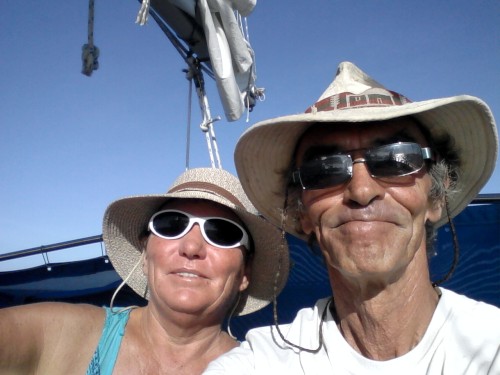
Who: Jackie and Colin Williams
Port: Luperon Dominican Republic

